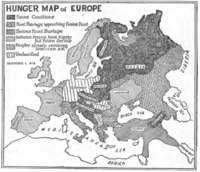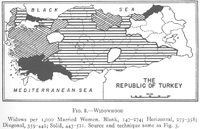Ottoman casualties of World War I
Ottoman casualties of World War I covers the civilian and military casualties of the Ottoman Empire. Ottoman Empire's casualties were enormous regardless of the method used in the calculations. The military casualties were published in the book Ordered to Die: A History of the Ottoman Army in the First World War, but the post-war partitioning of the Ottoman Empire made the estimation of the total civilian casualties harder. Also, it was not a novelty in world history to see from time to time people forced to move from one region to another, be it in the form of refugees, of population transfer, or of search for political asylum, but World War I and its aftermath caused migrations at unprecedented large scales, including the Ottoman Empire citizens.[1]

If looked at without breakdowns, the total Ottoman losses run almost as high as 25% of the population – approximately 5 million out of population of 21 million.[2] To be more exact, the 1914 census gave 20,975,345 as the population size, of which 15,044,846 was part of the Muslim millet, 187,073 part of the Jewish millet, 186,152 not belonging to any millet, and the remaining 5,557,274 shared by other millets.[3]
Among the 5 million, 771,844 were military casualties killed in action and other causes.[4] The military only covers 15% of the total casualties. The main question is what happened to 85% (spread over all millets) of the casualties, which is more but not less than 4,000,000. Ottoman statistics analyzed by Turkish Kamer Kasim (Manchester University, PhD), claims that cumulative percentage was 26.9% (higher than 25% reported by western sources) of the population, which this size stands out among the countries that took part in World War I.[5] To understand the size of the issue, Kamer Kasım's %1.9 increase on the totals adds 399,000 civilians to the total number, which has not been reported in western sources.
| Millets | Prewar | Civilian | Military | Post-War | |||||
|---|---|---|---|---|---|---|---|---|---|
| % | 1914 Census[3] | Other sources | Military perished | Civilian perished | Total perished | Survived | |||
| Armenian | 16.1% | Unknown[6][7] | |||||||
| Greeks | 19.4% | ||||||||
| Jews | .9% | 187,073[3] | |||||||
| Assyrian | 3% | ||||||||
| others | .9% | 186,152[3] | |||||||
| Muslim | 59.7% | 12,522,280[3] | 9,876,580 | 2,800,000 (18.6%)[4] | 507,152 (5.1% of its group)[4] | ||||
| Total:millets | 100% | 20,975,345[3] | 507,152 (2.4% of its group)[4] | 4,492,848 | 5,000,000[2] | ||||
Ottoman military casualties
Until World War I, Istanbul's civilian Muslim population and non-Muslim millets (minorities for some sources) were exempt from the conscription[8] Making exception of the indirect effects of often perennial arrangements, such as those that existed for the labor force of the arsenal and the dockyards. Full conscription was applied in İstanbul for the first time during World War I, and a lasting phraseology describes the Dardanelles Campaign as Turkey having "buried a university in Çanakkale". Non-Muslim Millets (minorities for some sources) were also issued a general call to serve in the military for the first time during World War I in the history of the Empire; but they did not participate in action and served behind the lines.[8] At the end of the war, many families were left with the elderly, children and young widows, see the figure widowhood in Anatolia. Given that the Ottoman Empire was engaged in nearly eight years of continuous warfare (1911-1918 Italo-Turkish War, Balkan Wars, World War I) social disintegration was inevitable.[9]
H. G. Dwight relates witnessing an Ottoman Military burial in Constantinople (modern-day Istanbul) and took pictures of it. H. G. Dwight says that the soldiers were from every nation (ethnicity), but they were only distinguished by their religion, in groups of "Mohammedans" and "Christians". The sermons were performed as based on the count of Bibles, Korans, and Tanakhs in provenance of the battlefield. This is what the caption of one slide reads (on the right):
One officer was left, who made to the grave-diggers and spectators a speech of a moving simplicity. "Brothers," he said, "here are men of every nation - Turks, Albanians, Greeks, Bulgarians, Jews; but they died together, on the same day, fighting under the same flag. Among us, too, are men of every nation, both Mohammedan and Christian; but we also have one flag and we pray to one God. Now, I am going to make a prayer, and when I pray let each one of you pray also, in his own language, in his own way.
When war was declared in Europe in 1914, there was only one military hospital in Van, Turkey, which was soon overcrowded with wounded and sick people.[10] The conditions were extremely bad; There were only two surgeons and no nurses, only male soldiers helping.[10] The conditions on the whole in the Ottoman army were almost bad beyond description. Soldiers, even at the front and who received the best care in comparative terms, were often (a) undernourished, (b) underclothed; troops deployed at high altitude in the mountains of Eastern Anatolia often had only summer clothes; Ottoman soldiers in Palestine often took great risks just to rob the British dead of their boots and even clothing; and (c) largely suffering from diseases (primarily cholera and typhus), which took many more lives than the actual fighting.[11] The German general Friedrich Freiherr Kress von Kressenstein, in a report he wrote to army group headquarters on 20 October 1917, describes how a division (the 24th) that departed from Istanbul-Haydarpaşa Terminal with 10,057 men arrived at the Palestinian Front with only 4,635. 19% of the men had to be admitted to hospitals since they were suffering from various diseases, 24% had deserted and 8% were allocated on the way to various local needs.[12][13]
| Category | Totals[4] |
|---|---|
| Total number of conscripts and officers mobilized | 2,873,000 |
| Killed in action | 175,220 |
| Missing in action | 61,487 |
| Died of wounds | 68,378 |
| Perished from diseases and epidemics | 466,759 |
| Dead: Killed in action and other causes | 771,844 |
| Seriously wounded (permanent loss, including died of wounds) | 303,150 |
| Total wounded in action | 763,753 |
| Prisoners of War (combined from all theaters of war) | 145,104 |
| Absent without leave | 500,000 |
Civilian casualties
Armenians
The Ottoman Empire committed massacres against the Armenian civilians in the country from 1915-1922 killing approximately 1,500,000 Armenians.[15]
Assyrians
The Assyrian Genocide was the massacre of the Assyrian population in the Ottoman Empire, which were in the regions of southeastern Turkey and the Urmia region of Iran, were deported and massacred by Ottoman and Kurdish armies in 1914 and 1920. Sources have put the death tolls at around 300,000.
Greeks
The Ottoman Empire under the Young Turks, followed by Mustafa Kemal and his Nationalists, committed genocide against their Greek citizens from 1914–1922, killing approximately 750,000 Greeks, 353,000 of whom were Pontic Greeks from the Black Sea area.
Muslims
The closest estimate of Muslim civilian casualties in this period is around 500,000.
After the partitioning of the Ottoman Empire, for reliability reasons, the data regarding the Muslim casualties had to be collected by region. The records regarding the Muslim civilians were sealed at the time of the Paris Peace Conference, and there is very little literature review on the Muslim millet, compared to Christian millet of the Empire (see: Armenian casualties).
One plausible explanation that needs further study may be attributable to productivity patterns of the Muslim millet, which could have dropped beyond sustainable levels since most of the men were under arms.
The Anatolian refugees included people who had migrated from war zones and immediate vicinity attempting, by doing so, to escape persecution. For World War I, the relatively most reliable sources can be found for Anatolia, especially in relation to the Caucasus Campaign. There is a total number reached and reported by the Ottoman Empire at the end of 1916. On the basis of previous Ottoman census, the Turkish historian Kamer Kasim (Manchester University, PhD), arrives at the conclusion that the movements of refugees from the Caucasus war zone had reached 1.500.000 people who were relocated in the Mediterranean region and Central Anatolia under very difficult conditions.[5] Kamer Kasım's number or any other number on this issue has not been reported in western sources.
The most horrible cases originate from the current region of Syria, a part of Ottoman Empire until the end of the war. The civilian casualties of Syria was covered in a detailed article (the whole of Greater Syria, and thus including Akkar) by Linda Schatkowski Schilcher.[16] Contributing to as many as 500,000 deaths of the civilians living in this region in the 1915-1917 period, the study lists eight basic factors: (a) the Entente powers' total blockage of the Syrian coast; (b) the inadequacy of the Ottoman supply strategy; deficient harvest and inclement weather; (c) diversion of supplies from Syria as a consequence of the Arab revolt; (d) the speculative frenzy of a number of unscrupulous local grain merchants; the callousness of German military official in Syria, and systematic hoarding by the population at large.[16] In a series of graphs and charts discovered in the Ottoman archives that date to 1915, Zachary J. Foster has shown that hundreds of Lebanese were starving to death or dying from starvation-related diseases (between 156-784) everyone month of the war from the fall 1915 onwards.[17]
See also
- World War I casualties
- Ottoman persecution of Alevis
- Persecution of Ottoman Muslims
External links
- Baş, Mehmet Fatih: War Losses (Ottoman Empire/Middle East) , in: 1914-1918-online. International Encyclopedia of the First World War.
Notes
- S.C Josh (1999), "Sociology of Migration and Kinship" Anmol Publications PVT. LTD. p 55
- James L.Gelvin "The Israel-Palestine Conflict: One Hundred Years of War " Publisher: Cambridge University Press ISBN 978-0-521-61804-5 Page 77
- Stanford Jay Shaw, Ezel Kural Shaw "History of the Ottoman Empire and Modern Turkey" Cambridge University page 239-241
- Edward J. Erickson (2001). Ordered to Die: A History of the Ottoman Army in the First World War. Greenwood Publishing Group. p. 211. ISBN 978-0-313-31516-9., Foreword by General Huseyin Kivrikoglu
- Kamer Kasim, Ermeni Arastirmalari, Sayı 16-17, 2005, page 205.
-
- File:US State Department document on Armenian Refugess in 1921.jpg
- McCarthy, Justin (1983), Muslims and minorities: the population of Ottoman Anatolia and the end of the empire, New York: New York University press, ISBN 9780871509635
- Nur Bilge CRISS, "Istanbul under Allied Occupation 1918–1923", 1999 Brill Academic Publishers, ISBN 90-04-11259-6 p22
- Nur Bilge CRISS, "Istanbul under Allied Occupation 1918–1923", 1999 Brill Academic Publishers, ISBN 90-04-11259-6 p21
- Grace H. Knapp; Clarence D. Ussher (1915). The Mission at Van: In Turkey in War Time. Privt. Print. [Prospect Press]. pp. 41–43.CS1 maint: extra punctuation (link)
- Erik-Jan Zürcher, "The Ottoman conscription system in theory and practice, 1844-1918", in: Erik Jan Zürcher (ed.), Arming the State: Military Conscription in the Middle East and Central Asia, London: I.B. Tauris, 1999, 88.
- Hans Kannengiesser, The campaign in gallipoli, London Hutchinson, 1927, p.266
- Erik Jan Zürcher, "Between Death and Desertion. The Experience of the Ottoman Soldier in World War I", Turcica 28 (1996), pp.235-258.
- WEBSTER, DONALD EVERETT (1935) "The Turkey of Ataturk" Philadelphia.
- Berlatsky, Noah. The Armenian Genocide. ISBN 9780737772296. OCLC 885224740.
- "The famine of 1915-1918 in greater Syria", in John Spagnolo, ed., Problems of the Modern Middle East in Historical Perspective (Reading, 1992), p.234-254.
- Zachary Foster, "4 Beautiful yet Horrifying Graphs of Death from Ottoman Lebanon, 1915-6," MidAfternoonMap.com' 16 February, 2015. (
